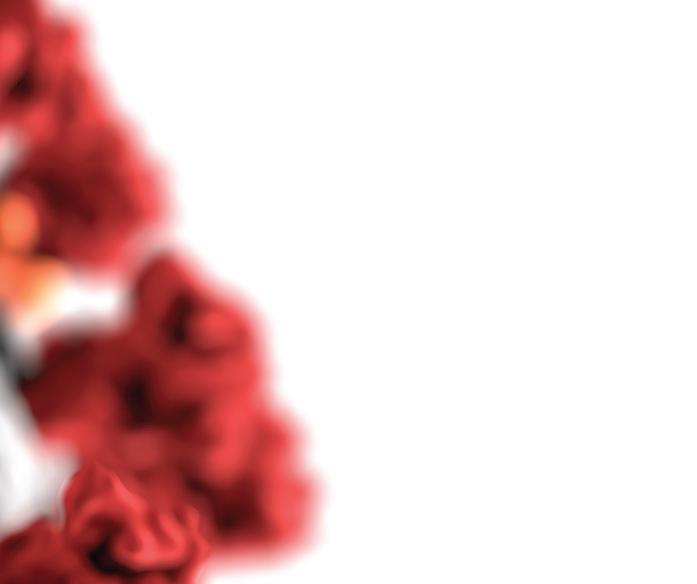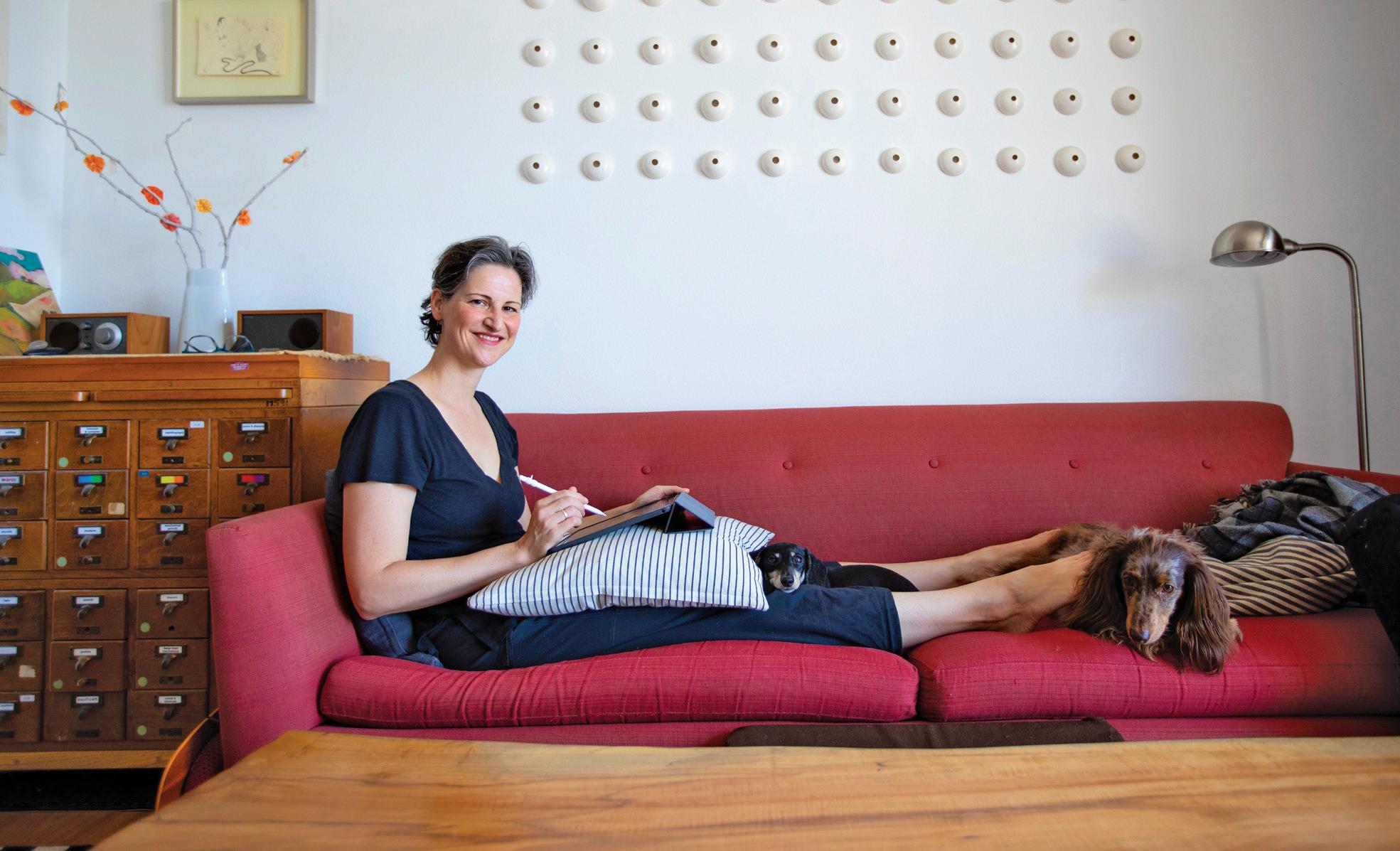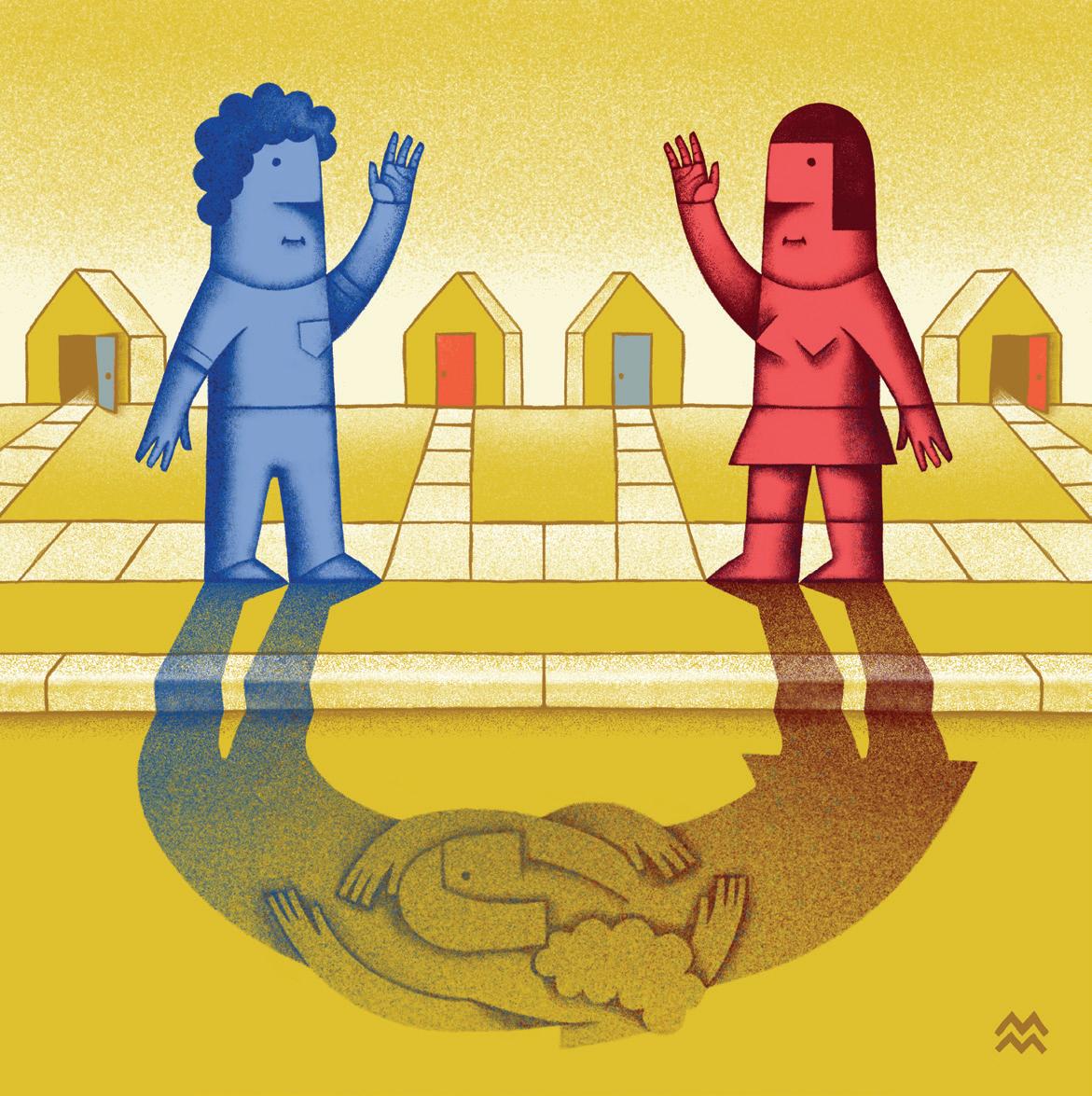
16 minute read
COVID-19 impact on campus
COVID -19

PLANNING FOR THE FALL

Iowa State prepares for students to return to campus amid the continuing COVID-19 outbreak
Who’s involved in planning for the fall semester? (Spoiler alert: It’s everyone)
When Iowa State transitioned classes to online learning back in March, it was an abrupt, necessary decision with little time to plan. By late April, the writing was already on the wall that returning to campus, even four months later, would be complex. On April 28, ISU President Wendy Wintersteen (L)(PhD ’88) announced the formation of an Executive Committee for Fall Planning. She assigned John Lawrence (L)(’84 animal sci, MS ’86 ag econ), vice president for extension and outreach, to be the group’s chair. The group has met daily since the first of May, Lawrence said, with the health and safety of bringing students, faculty, and staff back to campus as its primary goal. Work groups coming out of the main committee were tasked with academic continuity, public information, worker health and safety, research continuity, and more. In all, literally hundreds of administrators and staff have worked on fall planning, and faculty – though many were not on campus during the summer – also worked hard to prepare for the fall. “The faculty are really kind of doing double time,” Lawrence said in late July. “They’re preparing for a normal class, but they might be teaching a hybrid class, so they have to have an online option [ready]. Some of their students will end up in quarantine, so they have to capture their lectures if students have to watch it at a later date. It’s a tremendous load we’re putting on our faculty. It’s a lot of extra effort, and I’ve been very proud of the way faculty and staff have stepped up.” Lawrence said the comprehensive plan for the fall return to campus had three parts: 1. Identify and iso
late quickly, with follow-up monitor
ing. ISU is conducting its own COVID-19 testing, its own test John Lawrence analysis at the Veterinary Diagnostic
Laboratory, and expecting results in 24 hours. 2. Reduce the footprint. About half of ISU classes are expected to be online, and for the classes being held in person, there will be lower density in the classroom, required face coverings, and fewer people on sidewalks and in CyRide. 3. Ingrain healthy habits (wear a face covering, stay home if you’re sick, wash your hands, and physically distance). “It’s important to our success that we get people to buy in and do what they need to do to protect the entire community if we want to be back in the fall,” Lawrence said. “That continues to be one of our challenges. We know that if we don’t wear the face coverings and stay home if you’re sick, whether it’s here on campus or across the street in
Campustown, we could still have the spread of the disease that would threaten our fall.”
COVID -19 As we prepared this fall issue of VISIONS for you in August, changes in response to the COVID-19 pandemic were still being made at Iowa State on a daily basis. For up-to-the-minute information, go to Iowa State’s COVID-10 Response website: https://web.iastate.edu/safety/updates/ covid19/planning IMPACT ON CAMPUS

SWITCHING UP THE ACADEMIC CALENDAR The fall semester began one week earlier than usual, on Aug. 17, and the semester’s overall length will be shortened by four days of instruction. ISU President Wendy Wintersteen announced the new academic calendar on June 10. In order to reduce travel to and from campus, classes were held on Labor Day, and the semester will end on Wednesday, Nov. 25, the day before Thanksgiving.
Coronavirus research ramps up
Chemists at ISU are developing a paper-strip
urine test to detect infection by the coronavirus that causes COVID-19. It’s a little like a home pregnancy test, said Robbyn Anand, an Iowa State assistant professor of chemistry and leader of the project. But it’s a little more complicated than that. The test, designed to detect the presence of a coronavirus protein in a urine sample, will have to be 10 to 1,000 times more sensitive than a pregnancy test.
In response to the COVID-19 pandemic, Iowa State’s Office of the Vice President for Research
has selected seven high-impact projects to receive institutional funding through a new seed-grant program. Research projects will look at treatment for the disease, vaccine development, disease screening, testing, and more.


Nigel Reuel, an assistant professor of chemical
and biological engineering, is leading development of a no-touch, mail-in, fast-scan test that could be used to quickly test for COVID-19 or other outbreaks.
Robbyn Anand

CHRISTOPHER GANNON “ As a campus, while we cannot eliminate all risks associated with the pandemic, we are basing decisions on science and public health guidance, and our plans may be refined as new information becomes available and/or circumstances change.”



– ISU President Wendy Wintersteen, from a June 17 memo to faculty and staff in the division of academic affairs
IMPACT ON CAMPUS

WANT THIS? WEAR THIS.
A “Cyclones Care” campaign was launched late this summer to educate the campus community about the importance of wearing face coverings to improve the likelihood that in-person classes will continue. Beginning July 1, face coverings were required to be worn in classrooms, work spaces, and other areas where physical distancing is not possible. The university provided two Iowa State-branded cloth face coverings free to all students, faculty, and staff. “Face coverings are a key element of our ‘new normal,’” ISU President Wendy Wintersteen wrote in a June 24 memo. “Modeling this requirement and educating our campus with care and compassion are how we can help everyone understand the importance of this and other mitigation efforts.” She added, “We do not want face coverings to become a source of conflict on our campus.” Proactive planning tips have been provided to faculty and staff who may encounter students who are not willing to wear a face covering.


– Jonathan Wickert, ISU senior vice president and provost
10 ways Iowa State prepared for students to return to campus this fall
1. Fall classes are being offered three
ways: traditional face-to-face classes, with physical distance between seats, enhanced cleaning, and required face coverings; online classes; and blended or hybrid courses, using a combination of face-to-face and online teaching. 2. Large lecture-based classes are generally online and supplemented by smaller in-person learning opportunities. Medium and small lecture-based classes, studios, capstone, and team-based learning courses are taught in person or in blended formats as appropriate. Laboratory courses with fixed spaces and specialized equipment are being offered in person. 3. A modification of class scheduling has allowed more time between classes in order to reduce congestion during class changes. 4. Classroom density has been reduced to limiting in-person class sizes to 50 percent of a classroom’s normal instructional capacity. 5. Residence halls this fall offered single and double occupancy rooms and apartment-style living, and the move-in process was spread out over a two-week period (Aug. 3-16) to allow for physical distancing. Designated spaces have been reserved in case residence hall students need to self-isolate during the semester. Campus dining modified dining services to expand get-and-go options and locations, and contactless payment will be offered. 6. The Office of Admissions transitioned to online orientation over the summer. But “reimagined” Destination Iowa State activities were held in person Aug. 13-15, with face coverings, social distancing, smaller groups, and some virtual events. 7. At its June 4 meeting, the state Board of Regents voted not to increase tuition and mandatory fees for students during the 2020-21 academic year. 8. Students living in on-campus housing were required to be tested for COVID-19 before move-in. Tests were conducted at Lied Rec Center. During the semester, testing is available through Thielen Student Health Center and at Johnny’s in Hilton Coliseum. 9. Students are required to have their own laptops. Computer labs will not be open this fall in order to reduce the risk of transmission of the coronavirus between students sharing computers. The university is providing a laptop loaner program for students with financial need. 10. Students at higher risk to develop severe illness from COVID-19 were given preference for placement in online courses.
CHRISTOPHER GANNON

Miriam Martincic
Miriam Martincic is drawn to relatable, meaningful imagery
When forced into self-isolation last spring, some people baked bread. Others played the saxophone on their front porch. Miriam Martincic, an ISU assistant teaching professor of graphic design, made art.
Her illustrations, created on an iPad, form a COVID19 series that graphically represents the full gamut of the pandemic, from social distancing, hand-washing, and online teaching to health-care workers, loneliness, and even death.
“Making images regarding the current public health crisis centers and grounds me personally,” she said. “It actually makes me feel less alone. In uncertain time such as this, it’s easy to feel ‘nowhere.’ I share my work in hopes that these images can have a positive effect for others – bringing them a sense of connection in a time of isolation, helping to give form to difficult experience.”
Martincic says the “Social Distance” image is significant because it represents the loss of connectivity for many people. Another of her illustrations, “Til We Meet Again…,” represents the angst of not being able to dance or create through other performing arts.
“We definitely have a really big economic loss and loss of life, but for people who can’t do their art, for dancers, for musicians, for performers, there’s a big loss there, too. It’s a really deep loss,” Martincic said.

“SOCIAL DISTANCING” BY MIRIAM MARTINCIC

IMPACT ON CAMPUS
News

Kristen Obbink, a veterinary specialist at the Center for Security and Public
Health located in the College of Veterinary Medicine, will serve as the university’s COVID-19 public health coordinator through the fall semester. ISU’s public health plan outlines processes such as testing students for the virus, contact tracing and case investigation, mental health support, and administering vaccines when one becomes available.
Kristen Obbink
In a survey sent to 2,180 faculty and staff to assess the spring semester’s transition learning, 82 percent of respondents had converted at least one course to virtual delivery, though 57 percent said they had never taught an online or hybrid course before; instructors said the percentage of students who were actively engaged in their classes dropped from 75 percent to 42 percent after going online; write one word about how they were feeling, respondents most often said “overwhelmed,” “stressed,”
Innovation Center pivots

When the COVID-19 pandemic forced the Iowa State community to migrate online for the remainder of spring semester, the Student Innovation Center’s April grand opening was put on the back burner. However, construction, landscaping, and equipment installation pushed forward. This summer, students, faculty, and staff were working to ensure the building would be ready to open on Aug. 17. To comply with physical distancing and 50 percent capacity requirements, a few areas of the building will not be used as intended this fall. Two areas on the ground floor – the exhibit and “makerspace” areas – have been repurposed into classrooms to help the university’s room scheduling staff find instructional spaces. Innovative classrooms – such as a “learningin-the-round” room – that were initially to be assigned through a competitive application process are, for now, and 77 percent said they developed new teaching skills as a result of the transition. Finally, asked to
being used as traditional classrooms. “exhausted,” and “tired.”
Innovative projects: Members of the Cyclone engineering community made and donated face shields, cloth masks, gowns, scrub caps, and desk shields to share with health care professionals and others who needed personal protective gear; staff in the College of Design created “ear savers” to alleviate discomfort for hospital staff who have to wear face masks all day; faculty and staff in the Theatre Department produced more than 400 face masks made of material in ISU’s costume shop; ISU Extension and Outreach staff created online learning communities, “grab and go” materials, and 4-H curricula that families could pick up at Extension county offices; and a teaching lab coordinator in the Agricultural and Biosystems Engineering Department created plexiglass desk shields for use on campus.


–ISU Athletics Director Jamie Pollard, in a July 13 letter to Cyclone fans
TM
Iowa State’s fall 2020 commencement ceremonies and college convocations will be held in a virtual format on Saturday, Nov. 28. To view the celebration, go to https://virtual.graduation.iastate.edu
AS CLASSWORK BEGINS…
Early testing offers a snapshot in time
A total of 8,094 students were tested on campus for COVID-19 from July 31 to Aug. 16 during the move-in process. ISU’s Veterinary Diagnostic Laboratory processed the samples and provided results within 24 hours. Of those tested, 175 were positive, for a positive percentage of 2.2 percent. Students who tested positive were required to isolate for 10 days, either at home or in isolation rooms provided by the Department of Residence.
Students disregard health and safety guidelines
Hundreds of ISU students ignored social distance and face-covering guidelines on Aug. 15, the Saturday before classes began. Students gathered in large groups around bars in Campustown and for parties at private residences throughout Ames. In a joint statement, Toyia Younger, senior • May: ISU Athletics Director Jamie Pollard (L) announces that football will be played, but attendance in Jack Trice Stadium would be limited to approximately 50 percent capacity, or about 30,000 spectators. Only season ticket- holders would be allowed to attend the games. • June 3: The ISU Athletics Department an- nounces its first positive COVID-19 test results. • June 22: The Story County Board of Health recommends that Iowa State prohibit fans in the stands during fall sporting events. The recommendation comes after a surge of positive coronavirus cases in Story County. “We cannot think of any way these events can be made even remotely safe with the masses of people from all over the state who routinely attend these events,” the statement reads in part. • Summer: All student athletes are tested for COVID-19 upon returning to campus. Any student athlete testing positive is isolated from all team activities and community members. • July 13: In a letter to fans, Pollard writes, in part: “As leaders, we remain committed to safety first…. We must also be cognizant of the absolute need to generate revenues to sustain our long-term operations…This is why we are so committed to trying to find a solution to safely play college sports.” • Aug. 3: The Big 12 presidents vote to limit non- conference schedules to one game this season. vice president for student affairs, and Sharron Evans, dean of students, said: “Disregarding … health and safety policies jeopardizes the university’s ability to provide in-person experiences and increases the chance that all classes will move online. If students want to complete the fall semester on campus, this disregard must stop. “Gathering in large groups and not wearing face coverings puts the health and safety of our community at risk. Iowa State will continue to work closely with community partners to remind students of their responsibility, and if needed, enforce policies for nuisance parties. The university is committed to the goal of providing an on-campus experience, and we implore all students to do their part in keeping our community healthy and campus open.” On Aug. 21, ISU enacted a COVID-19 safety • Aug. 11: The Big Ten and Pac-12 conferences cancel their fall 2020 football seasons. • Aug. 11: The Big 12 Conference reworks the league’s 2020 football schedule. Iowa State’s first game is moved to Sept. 12; Oct. 17, previously selected for the Homecoming game, is no longer a gameday. • Aug. 14: Pollard sends a message to fans stipulating that face coverings are required at all times for fans attending games in Jack Trice
Stadium, no tailgating will be allowed, and park- ing lots open just two hours before game time. • Aug. 31: Seats for the first game are reassigned, with a maximum of 25,000 fans allowed in the stadium. • Sept. 2: The decision to allow fans at the first game is reversed. No fans would be allowed. • Sept. 4: Projecting a $30M deficit for athletics,
Pollard recommends additional pay reductions for coaches and staff, possible layoffs, elimi- nating sports, and closing Stephens Auditorium. • Sept. 9: Following a public outcry, ISU
President Wendy Wintersteen releases a statement saying that “the university and the athletics department are committed to working together to develop a plan for how Stephens will operate into the future for the benefit of campus and the Ames community.” • Stay tuned for additional changes: https://
cyclones.com
policy for student social gatherings, stating that all on- and off-campus gatherings must comply with the university face-covering mandate and physical distancing guidelines. Students violating the policy are subject to university discipline. Through testing conducted on campus during the month of August (not including move-in testing), 655 students were found to be positive for the coronavirus, along with 10 faculty and staff members. In late August, Ames was cited as having one of the highest numbers of new coronavirus cases per 1,000 people of any metro


PHOTOS ABOVE: MATT VAN WINKLE
The 2020 football season: An unprecedented timeline
area in the nation.
In August, the university was addressing unprecedented revenue losses due to COVID-19, projected enrollment declines, reduced state appropriations, reduced indirect cost recovery, and the increased costs of preparations necessary to enhance healthy outcomes for the fall semester. The revenue loss for FY21 for Iowa State’s educational fund is more than $41 million.










